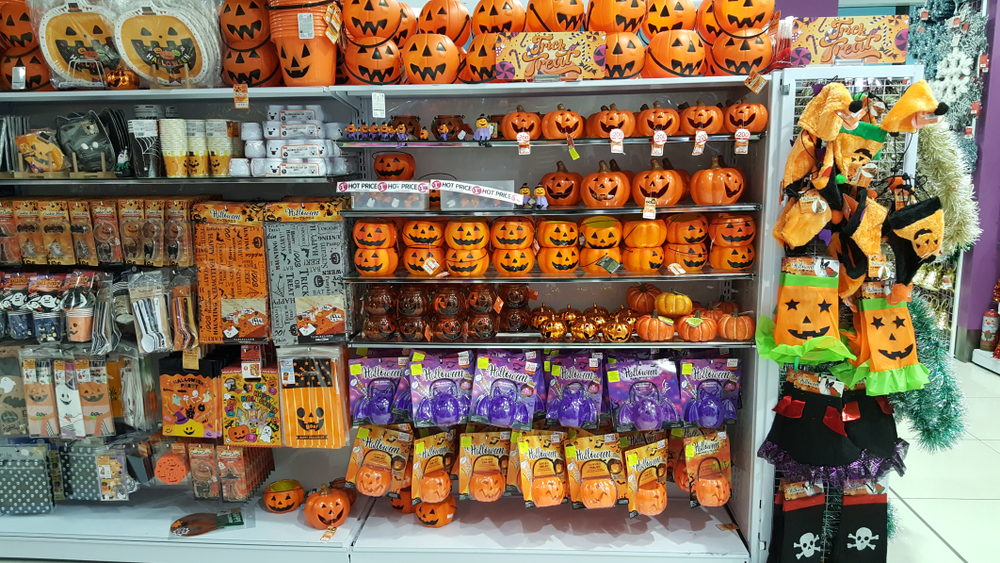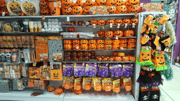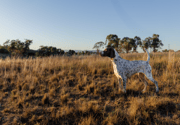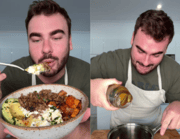
Halloween has transformed dramatically across Australia over the past decade, evolving from a barely recognised American import to a multi-generational, community celebration that’s captured the imagination of families nationwide.
Yet this growing embrace of spooky season has sparked an unexpected backlash from concerned parents who say retailers have crossed a line from festive fun into genuinely frightening territory.
Tim Doecke, a Queensland father, made a Change.org petition calling for stores to rethink their approach to Halloween displays after what he describes as a ‘traumatising’ experience at Kmart with one of his children. His petition, which has attracted close to 1,500 signatures, argues that many current Halloween decorations would ‘earn an MA15+ rating in film’ and shouldn’t be unavoidable for families doing everyday shopping.
‘One of our boys knows it’s Halloween season and he doesn’t want to go to the shops,’ Doecke explained. ‘He’ll close his eyes when we’re going past the checkout in Kmart because he wants to sleep well at night. The shops aren’t a safe place for him.’
Halloween's boom across generations
The timing of this debate coincides with Halloween reaching new heights of popularity in Australia. Recent research from the Australian Retailers Association shows that more than one in five Australians aged 18+, around 4.8 million people, are gearing up to don creepy costumes, decorate their haunted houses, stock up on lollies or throw a monster bash.
Particularly noteworthy is the dramatic surge in participation among older Australians. Participation among 50-to-64-year-olds rising to 21 per cent (up eight per cent) and over-65s also at 21 per cent (up 12 per cent). This represents a significant cultural shift for a generation that grew up when Halloween was virtually unknown in Australia.
With $450 million in Halloween spending expected in 2025, retailers have clear financial incentives to maximise the seasonal opportunity. However, this commercial enthusiasm may be outpacing consideration for the diverse needs of shopping families.
Much of it depicts violence, horror, and supernatural themes that would earn an MA15+ rating in film. Children cannot avoid these images, and parents lose the ability to control what their kids are exposed to.
When spooky becomes scary: The psychology perspective
Doecke's concerns aren't merely parental overprotection—they're backed by substantial research from child psychology experts. Clinical therapist Beth Tyson, who specialises in childhood trauma, warns that fake blood, scars, stitches, tombstones, among other things, can remind children about the traumas they've experienced.
Dr Natalie Scanlon from Texas Tech Health Sciences Centre takes this further, explaining that when kids are exposed to excessively scary movies, images, or even haunted houses, they tend to have some of the symptoms of Acute Stress Disorder or Post Traumatic Stress Disorder.
The concern isn't limited to children with obvious trauma histories. Hope Walker, who wrote about trauma-informed Halloween practices, notes that images and decorations portraying death or blood can be frightening for children who may have been physically harmed, seen someone be seriously injured, or in some other way had their life threatened.
Understanding trauma triggers in Halloween displays
- Masks that obscure faces and create uncertainty about identity
- Blood, wounds, and medical imagery that can remind children of injuries
- Themes of death and supernatural horror
- Jump scares and sudden loud noises from animatronics
- Dark, eerie atmospheres that can feel threatening to vulnerable children
The retail dilemma
The controversy highlights a genuine challenge for retailers trying to balance commercial success with community responsibility.
Halloween merchandise and displays drive significant revenue, particularly with the 2025 celebration falling on a Friday, creating an extended Halloween weekend.
However, this year has already seen items designed to fright and delight recalled for failing to meet regulations put in place to protect Australian consumers. Choice Australia has identified problems with dangerous button batteries, flammable clothing, and cosmetic products that failed to list ingredients properly.
The petition signers' stories reveal the real-world impact of increasingly graphic displays. One parent described her children aged 12, nine, seven, and four as 'constantly scared by the images and sights they see and experience in most shops in the lead up to Halloween,' resulting in 'nightmares, big questions about their safety'.
Another supporter noted: 'I work in early years and the number of families who are avoiding the shops because of Halloween displays is astounding.'
Finding middle ground
Doecke's petition doesn't call for eliminating Halloween displays entirely. Instead, he advocates for a cigarettes-and-alcohol approach, the most graphic content to designated sections where parents can make informed choices about their children's exposure.
This mirrors expert recommendations. Child psychologist Dr Vicky Wolfe suggests that moderate Halloween experiences can actually help children develop coping skills, but emphasises the importance of parental control and age-appropriate exposure.
Practical approaches to safer Halloween displays
- Designated sections: Placing graphic Halloween merchandise in clearly marked areas, similar to restricted sections for other age-inappropriate content
- Time-based displays: Limiting the most intense decorations to evening hours when fewer young children are shopping
- Clear signage: Warning parents about potentially disturbing content ahead
- Alternative pathways: Providing routes through stores that avoid the most graphic displays
Balancing Halloween fun with child safety
- Retailers could create designated sections for graphic Halloween content
- Clear signage and alternative pathways can help parents make informed choices
- Expert research supports concerns about traumatic impacts on vulnerable children
- Community discussion is needed to find solutions that work for all families
- The goal isn't eliminating Halloween but making it more inclusive and considerate
Broader community concerns
The Halloween display controversy intersects with wider community issues.
Inner West and Willoughby councils have raised environmental concerns about decorations, warning that fake spiderwebs and fishing lines could harm wildlife.
'Animals can get tangled in them or mistake the plastic for food, which can cause serious harm,' Willoughby Council noted, encouraging residents to 'choose or create decorations that are safe for nature and use less single-use plastic.'
A generational perspective
For many Australian grandparents and great-grandparents, watching Halloween's explosive growth raises questions about cultural change and child welfare.
Having grown up in an era when trick-or-treating was unknown and scary imagery was largely confined to specific contexts like horror films with age restrictions, the normalisation of graphic content in everyday shopping environments represents a significant shift.
The petition's popularity suggests this isn't a fringe concern. With nearly 1,500 signatures and growing support, it reflects genuine community unease about the direction of Halloween commercialisation.
Moving forward constructively
The debate ultimately isn't about banning Halloween or restricting creative expression. It's about finding ways for communities to celebrate while protecting the most vulnerable members—particularly young children who may have experienced trauma or who simply aren't developmentally ready for graphic horror content.
As Australia continues to embrace Halloween traditions, there's an opportunity to do so in ways that reflect Australian values of fairness, inclusion, and looking out for one another. The petition represents a call for retailers to consider not just commercial opportunities but their broader responsibilities to the communities they serve.
The conversation extends beyond Halloween to broader questions about childhood, community standards, and corporate responsibility in an increasingly commercial culture. For older Australians who've witnessed significant social changes, it raises familiar questions about balancing progress with traditional values of child protection and community consideration.
What do you think about Halloween displays in shops? Have you noticed them becoming more graphic over the years, and should retailers do more to consider families with young children? Share your thoughts and experiences in the comments below.







